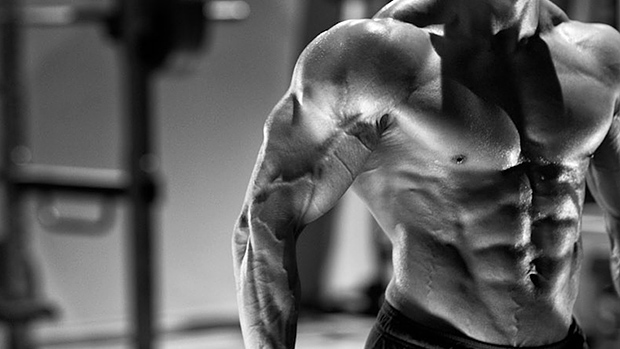For strength training addicts like us, the bench press has a kind of mythical aura surrounding it. We may speak different languages, have different skin colors, live different lifestyles, and fight different battles, but as gym rats we must all answer one universal question:
"Yo, how much ya bench?"
Well, how much do you bench? Probably not as much as you'd like! In fact, chances are that your bench press numbers have been stagnant or increasing very slowly, so much so that it may even have zapped your motivation. Fear not, my friend, the crazy Canuck has something in store for you.
In this article, I'll outline a bench press specialization cycle that'll drastically improve your max bench. It's unorthodox, but highly effective. The average gain on this program has been 40 pounds in 8 weeks with my advanced trainees (who benched at least 300, some over 400 pounds, even before they took on this program). The biggest gain I've seen so far with this method is 65 pounds in 8 weeks; the smallest was 30 pounds which is still a pretty good improvement.
Are you ready to boost your bench press PR by 30 to 65 pounds, maybe even more? Then let's get started!
Particularities of the Program
Maximizing strength in an exercise is as much about motor learning as it is about muscle growth. Simply put, the neural aspects of strength production (motor unit activation, intramuscular coordination, intermuscular coordination, reduced inhibition) are what will limit how strong you can be. Gain as much muscle as you want, but if you have the nervous efficiency of a senile granny you'll never be able to realize Herculean feats of strength.
The key to motor learning is frequency of practice. The number of repetitions is somewhat important, but it still takes a backseat to frequency. To increase strength in a specific movement, it's best to do a little work often than a lot of work infrequently.
You may have heard that "practice makes perfect." Sorry, but this is simply not true. Practice makes permanent, not perfect. Practice bad motor habits and you'll make this wrong technique/activation factor automatic. We should say that perfect practice makes perfect. To become good at something you must replicate the required motor action as closely to the target as possible.
Soviet weightlifting literature states that weights lower than 90% of the maximum don't involve the exact same activation patterns as during maximum lifts. Similarly, loads of more than 120% of the maximum (performed for partial reps or eccentric reps) also require different motor qualities and aren't completely specific to maximum lifts.
So what we want to do is perform a lot of maximum-specific reps. That means performing a lot of reps in the 90 to 120% range. Since this is demanding work, it's impossible to perform a large workload at every session. This would lessen the quality of the reps due to neural and metabolic fatigue. This is one more reason to use a high frequency bench press schedule.
In this program, there'll be three bench press workouts during the week. The muscles involved in the bench press will be worked in one of these three workouts, and so will the unrelated muscles. Work for the non-related muscles will be decreased during this cycle to allow the body to have more of its adaptation reserves to spend on improving the bench press.
The biggest bench press workout is on Sunday, where you'll actually perform three mini sessions of 30 to 45 minutes divided by at least 30 minutes of rest, and preferably more than that. The second bench press session will be on Tuesday and will be of a lower average intensity. We'll use that workout to develop starting-strength from the beginning of the concentric phase of the movement. (The more starting-strength and explosive-strength you have, the easier it'll be to blast through your sticking point.)
Finally, the third session on Thursday is an overload session focusing on partial reps from the strongest mechanical position, as well as static holds. The complete schedule looks something like this:
- Sunday: Bench press (high stress) / triceps / anterior and medial deltoids
- Monday: Off (restorative measures)
- Tuesday: Bench press (starting-strength), biceps, upper back, rear deltoids
- Wednesday: Off (restorative measures)
- Thursday: Bench press (overload), lower body
- Friday: Off (restorative measures)
- Saturday: Off (restorative measures)
You'll notice that the training week starts on Sunday and not on Monday. That's because the first weekly session requires that you have a lot of free time on your hands. For those of you with jobs or school, Sunday is best for that purpose.
Sunday: Bench Press, High Stress
Mini-Session 1
Pre-workout strategy 1: About 30 minutes before the session, take one serving of Brain Candy® along with 200mg of caffeine. This will activate your nervous system and maximize your strength potential.
Pre-workout strategy 2: Before the first work set on the bench (after your 2-3 warm-up sets) place an icepack on your abdomen for 2-3 minutes. This will restrict blood flow to the heart (due to vasoconstriction) which will stimulate a panic response, releasing adrenalin and noradrenalin, potentiating your strength and power for the upcoming workout. (Yes, yes, it sounds weird, but it works!)
Exercise 1: Bench Press
Method: Extended cluster – Using a load that's 90% of your maximum (after properly warming up), you'll perform as many singles (sets of one rep) as possible while taking no more than 30 seconds of rest between sets. When you can no longer lift the barbell the exercise is over. Obviously, you rack the bar after each rep as you rest. Shoot for 8 to 10 singles. Tempo isn't important, just lower the bar under control, but not purposefully slow.
Exercise 2: Decline Close-Grip Bench Press
- Method: Regular sets
- Sets: 5
- Reps: 4-6
- Rest intervals: 90-120 seconds
- Tempo: Control the load during the eccentric (lowering) portion, but no need to go too slow.
Mini-Session 2
If there's more than two hours between both sessions, repeat the two pre-workout strategies stated above. If less than two hours separate the two workouts, only use the icepack strategy.
Exercise 1: Bench Press
Method: Regular cluster – Using a load that's 90% of your maximum (after properly warming-up), perform sets of 5 reps, resting 10-12 seconds between each of the 5 reps of the set. Rack the bar after each rep of the set. Perform 5 of those cluster sets with 3-4 minutes of rest between them.
Exercise 2: Dumbbell Shoulder Press
- Method: Regular sets
- Sets: 5
- Reps: 4-6
- Rest intervals: 90-120 seconds
- Tempo: Again, control the load during the eccentric portion, but no need to go too slow.
Mini-Session 3
If there's more than two hours between sessions two and three, repeat the two pre-workout strategies stated above. If less than two hours separate the two workouts, only use the icepack strategy.
Exercise 1: Bench Press
Method: Drop set cluster – Load the bar with 95% of your maximum, but use small plates so that you can remove weight on each rep. You should arrange the weight so that you can remove around 5% per rep for 4 reps. For example, if you bench press 315 you'd load the bar this way:
- Rep 1: 95% (300lbs) = 2 x 45lbs; 2 x 10lbs, 3 x 5lbs, 1 x 2.5lbs per side (plus bar)
- Rep 2: 90% (285lbs) = 2 x 45lbs; 2 x 10lbs, 2 x 5lbs per side (plus bar)
- Rep 3: 85% (265lbs) = 2 x 45lbs; 1 x 10lbs, 2 x 5lbs per side (plus bar)
- Rep 4: 80% (255lbs) = 2 x 45lbs; 1 x 10lbs, 1 x 5lbs per side (plus bar)
Perform a cluster set of 4 reps, racking the bar after each rep, resting no more than 12 seconds between each rep (just the time needed for your spotter to remove the plates). Perform 3 such sets with 3-4 minutes of rest.
Exercise 2: EZ-Bar Lying Triceps Extension
- Method: Regular sets
- Sets: 5
- Reps: 4-6
- Rest intervals: 90-120 seconds
- Tempo: Control the weight during the lowering portion, but no need to go super slow.
Post-Workout Recommendation: By now you probably know the effects of proper post-workout supplementation. If you want maximum results from this program, you should ingest one serving of Mag-10® after each of these mini-sessions, especially if there's more than two hours between two sessions. It might seem like a lot of Mag-10, but since you only have three workout days and five weekly sessions it doesn't amount to more than with a regular training week. You should at least consume one serving of Surge after the third session, or split one serving into two half-servings used between two sessions.
Tuesday: Bench Press, Starting-Strength
For many years, starting-strength and explosive-strength have been neglected in the bench press, the reason being that most people have their sticking point at the mid-range point of the movement. They reasoned that the beginning of the movement was strong enough and didn't require any special attention, an assumption that's been made even stronger among powerlifters who use a bench press shirt, since this piece of equipment is of great help in the initial upward thrust of the bar.
However, starting and explosive strength really are important for raw bench presses (and even shirt-wearing lifters) because the stronger and the more explosive you are at the start of the lifting portion, the more acceleration you can impart to the bar. The faster you can lift the bar, the easier it'll be to blast through the sticking point since the deceleration caused by the weak biomechanical position of your sticking point will be counterbalanced by the momentum of the bar.
Pre-Workout Strategy: Use one serving of Brain Candy 30 minutes before the workout.
Exercise 1: Bottoms-Up Bench Press
Method: Dead-stop lifting – Set a bench in the power rack and place the pins so that the bar is around an inch from the chest. Place the barbell on the pins, lie down on the bench and press!
Start each rep from a dead stop by replacing it on the pins. You'll perform 6 sets of 3 reps using around 80 to 85% of your maximum. To be truthful, this percentage range is only a broad recommendation as starting-strength can vary widely from lifter to lifter. Some will be able to use up to 90% of their max bench press while others will struggle with 70%. Basically what I want you to do is to use a load that's challenging to complete for 3 dead-stop reps. Take 2-3 minutes between each set.
Exercise 2: Iso-Relaxation Speed Bench Press
- Sets: 8-12
- Reps: 3
- Load: 45-50%
- Rest intervals: 60-90 seconds
Description: Lower the bar to your chest. As it touches it, fully relax all your pressing muscles (keep your glutes and lower back tight). Wait 3 seconds to allow the elastic energy/myotatic reflex to dissipate and press the barbell up as fast as possible.
Exercise 3: Lat Pulldown or Weighted Chin-ups
- Method: Regular sets
- Sets: 5
- Reps: 4-6
- Rest intervals: 90-120 seconds
- Tempo: Again, control the load during the eccentric portion, but no need to go too slow.
Exercise 4: EZ-Bar Standing Curl
- Method: Regular sets
- Sets: 5
- Reps: 4-6
- Rest intervals: 90-120 seconds
- Tempo: Control the negative, but no need to go slow
Exercise 5: Seated Cable Row to the Neck
- Method: Regular sets
- Sets: 3
- Reps: 8-12
- Rest intervals: 60-90 seconds
- Tempo: Again, control the load during the lowering portion, but no need to go too slow
Post-Workout Recommendation: Since this is a relatively high volume workout, I recommend that you take two servings of Mag-10 after your session (or one during and one afterwards). Again, if strapped for cash, one serving is better than nothing, but remember that extreme results require extreme measures!
Thursday: Bench Press, Overload
Pre-workout strategy 1: About 30 minutes before the session take two serving of Brain Candy. We want to reach a state of super neural potentiation without sympathetic overactivation.
Pre-workout strategy 2: Take 1000mg of vitamin C along with your Brain Candy. This training day relies heavily on accentuated eccentrics and supra-maximal weights, two things that can cause a lot of muscle soreness. Vitamin C has been shown to reduce muscle soreness as well as cortisol production.
Pre-workout strategy 3: Before the first work set on the bench press (after your 2-3 warm-up sets) place an icepack on your abdomen for 2-3 minutes.
Exercise 1: Bench Press
Method: Maximal eccentrics – Load the bar to 100% of your concentric (normal lifting) maximum. You'll lower the bar under control (in 3-5 seconds) and a partner will help you lift it back up. You want to perform as many reps as you can while keeping the load under control. Normally we're talking about anywhere from 3 to 6 reps. Perform 4 such sets with 3-4 minutes of rest.
Exercise 2: Partial Pin Press
Method: Strong portion partials – Set a bench in the power rack and place the pins so that the bar is above your sticking point (elbows around 110-130 degrees) as it rests on the pins. Place the barbell on the pins, lie down on the bench and press!
Don't let the bar hit the pins on the way down; stop it just short and press back up. Perform 4 sets of 3 reps with as much weight as you can handle. Most people will be able to use 100-110% of their maximum bench press but don't worry if you're weaker than that; simply make sure that each set is challenging. Rest 2-3 minutes between sets.
Exercise 3: Back Squat
- Method: Regular sets
- Sets: 5
- Reps: 4-6
- Rest intervals: 90-120 seconds
- Tempo: Once again, just control the load during the negative portion.
Exercise 4: Leg Curl
- Method: Regular sets
- Sets: 5
- Reps: 4-6
- Rest intervals: 90-120 seconds
- Tempo: Control the load during the eccentric portion, but no need to go too slow.
Post-Workout Recommendations: Once again, ingest a serving of Mag-10 right after your session, but I also recommend that you down 200-400mg of r-ALA ten minutes before you drink your shake (so just before the end of your workout). Eccentric training can reduce insulin sensitivity and thus the rate of glycogen restoration; r-ALA can increase muscle glucose uptake and thus make the post-workout drink more effective. Also, ingest another 500-1000mg of vitamin C.
Restoration Modalities
To make the most out of this training program you must maximize muscle and neural recovery. This is especially important considering the high frequency of pressing work as well as the high level of intensity. Some useful techniques include:
- Cryokinetics: This technique refers to ice massage. Put some baby oil on your muscle (to prevent shock) and put ice in the middle of your muscle belly. Start to gently massage the muscle in circular motion with the ice. Gradually increase the diameter of the circles. Do this for 2-3 minutes for your chest, triceps and anterior deltoids.
- Walking: Take a 45-60 minute walk, preferably in a calm or pleasing setting. Go slow as to not fatigue yourself; all we want is to activate peripheral blood flow which will facilitate recovery.
- Contrast showers: Alternate between 30 seconds of cold water (as cold as you can stand) and 2 minutes of hot water. Perform this cycle 3-4 times and make sure that your chest, shoulders and arms receive the treatment.
- Sauna: Once or twice per week you can use a sauna to help with regeneration. Stay in the sauna for 5-10 minutes (no more) and avoid moving (lie down if possible). After your sauna, go take a short contrast shower of 20-40 seconds of cold water and 1-2 minutes of warm (not hot) water.
- Deep tissue massage: If available to you, a weekly sports massage can make a drastic difference in your rate of progress. It can help with recovery (slightly), but more importantly, it can help break down adhesions in the muscles which can decrease its contractile strength. Ideally you'd use a therapist certified in Active Release Technique (ART) on Friday. If you can't afford ART, a deep tissue massage will still be of value.
Conclusion
As you can see, this is a program that's quite exhaustive and complete. If you follow it to a "T" you're sure to get at least a 30 pound increase on your bench press in 8 weeks, and probably more than that.
If you follow the exact pre-workout, post-workout and restorative measures you might gain 60 pounds or more on your bench press! And this isn't hype, it's science! Give it a try and see for yourself how high you can go!





